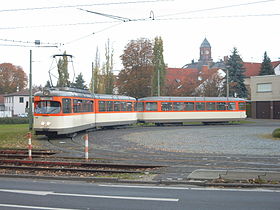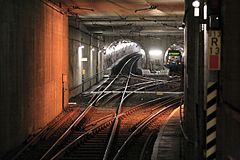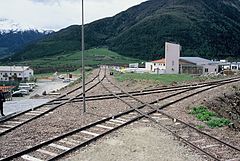Turning system

A turning system or sweeping system is a system in rail traffic that enables rail vehicles to change the direction of travel on a railway line . It can be designed as a single or multi-track arrangement of butt tracks , as a transfer track , as a turning loop , as a track triangle or in rare cases as a pentagon . If the turning system is at the end of a multi-track line, it also enables the tracks to be changed. While turning loop, Gleisdreieck and Gleisfünfeck also means vehicles allow you to change the direction of travel, have vehicles that would change on a turning system with stump tracks the direction of travel, designed for both directions be.
A borderline case are switchbacks and terminal stations at which the train changes direction, but not (or not necessary) to return the route.
Examples
Turning system with siding

These sweeping systems are available both at the end of the route and in stations on the way. The train drives onto the arrival track to get off, then drives into the sweeping system, the driver changes the driver's cab, the train drives over a switch to the departure track. The possible headway time is shortened compared to sweeping on the platform, while the time that the driver needs to change the driver's cab, other trains can run on the platform tracks. At the end of the route, all the sweeping tracks can usually be reached from all the platform tracks. This type of turning system occurs in underground , suburban and light rail networks. There are also turning tracks outside of terminus stations, they can be between or, if there is not enough space, next to the main tracks. In this case, however, when driving into the sweeping track, other journeys on both tracks are impaired.
Sweeping systems at subway stations are required for reinforcement trips, for route interruptions due to disruptions or construction work and as operational reserves. In many companies, they also serve as a storage facility during the nightly shutdown. They also arise when a route is extended. Then it is often advisable to expand the direct connections between the tracks to reduce wear. In systems that are designed for particularly high performance, additional platforms are also set up for trains leaving and entering. One example is the Berlin Nordbahnhof .
Change of track

In the case of U-, S-Bahn and city railways , for so-called short sweeping, track changes are also used in front of the terminal stop or intermediate turning stations - for example on the Stuttgart city railroad . The train drives onto any track, the driver changes driver's cab on the platform and the return journey in the opposite direction can begin. Then he drives over two points on the right track. During the turnaround time, however, the platform track is occupied; if the trains are in rapid succession, turning on the platform of an on-the-go station is not practical. That is why such track changes are also called "emergency sweeping systems". There are double track changes as a switch trapezoid as well as a double track connection with an additional steep crossing, whereby the first variant is more cost-effective, the second more space-saving. If there is not enough space, the trains also turn permanently on the platform, for example in Berlin 's Ruhleben underground station . With an island platform, this is not a problem for the passengers.
photos
Two-track system sweeping the circle line at the station BerlinGesundbrunnen , 1986
Three-track sweeping system on basic route A of the Frankfurt (M) subway at Frankfurt (M) Süd station. The outer tracks (the one on the left in the picture) are prepared for a line extension
Wendestern ( track pentagon ) in Mals train station (Vinschgau)
See also
literature
Lothar Fendrich, Wolfgang Fengler: Railway Infrastructure Manual . 2nd Edition. Springer Vieweg, Berlin 2013, ISBN 978-3-642-30020-2 , p. 478 ff .







